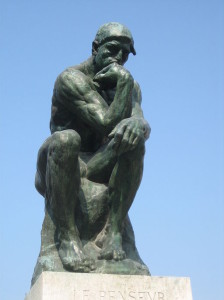 While sitting on my throne yesterday, I did what every human does when he or she sits down on a toilet seat and gets comfortable. One sits and thinks, or one sits and plops. I found myself getting so comfortable, I started thinking about what makes something comfortable or not.
While sitting on my throne yesterday, I did what every human does when he or she sits down on a toilet seat and gets comfortable. One sits and thinks, or one sits and plops. I found myself getting so comfortable, I started thinking about what makes something comfortable or not.
I’m certain these thoughts were a result of a conversation I had had with my husband a few days ago when he informed me that his search for the perfect toilet seat was over. “I have found the best one for me,” he said. He went on to explain that for years he thought the round wooden ones were best because of their solidness and warmth. But over the years the plastic ones had improved in density and the elongated, contour shape was more comfortable.
As I sat on my wooden toilet seat in our upstairs bathroom, my mind drifted to toilets I’d seen in my travels. While touring the Topkapi Palace in Istanbul, Turkey years ago. I viewed the sultan’s squat toilet—a hole in the ground surrounded by a fine marble floor and walls. One afternoon, at a fancy five star restaurant in the hills near Istanbul, I was directed up a stone path that lead to the women’s latrine. It was immaculately clean, with shiny marble floors, beautiful inlaid mosaic tiled walls, and a porcelain sink sitting atop a carved olive wood stand. I marveled at the elegance. I pushed open the door to the private toilet. Whoa! No commode in sight, just a shiny ceramic square shaped squat box with a pair of footpads on either side of the drain. So I scooped up my long dress, straddled the hole, and did my biz. No toilet paper in sight, but a clay jug of water was positioned close by for cleaning up. Not very comfortable.
Days later, while wandering through the ancient city of Ephesus, one of the largest and most important in the Greco-Roman world, I was amazed to see paved roads, terraced houses for the wealthy with luxurious bedrooms, bathrooms, kitchens, and a triclinium room for dining and reclining. The Ephesians had advanced public works with impressive plumbing. The municipal toilets, located in the big outdoors, were long marble benches with horseshoe shaped holes. Below the bench was a water channel for carrying away wastes. I sat on one of the horseshoe shaped seats for a photo op, but of course didn’t use it. The seat itself felt quite comfortable.
My mind skipped ahead to other toilets I’d encountered along life’s way. From holes in the ground, to buckets, to outhouses, to a chair with a hole in the seat and a pot underneath. All worked as collectors of waste and were absolutely necessary when I needed to go. Some however more comfortable than others.
There was a really nice bathroom in our hotel room in Cairns, Australia, when we visited there in 1998. A very comfortable toilet seat … until the chambermaid informed me that in Australia one has to be extra careful when using the toilet because spiders often hide under the seat. Not just any ole’ spiders, but the small, deadly ones. From then on, I inspected every toilet seat I encountered in Australia.
My most uncomfortable toilet seat ever was in London. While visiting a writer friend in a marvelous old Victorian mansion (resembling the Munster Mansion), I sat for hours in his wife’s private suite. A songwriter and poetess, she was entertaining. Needing a potty break, I offered to go downstairs and use the guest bathroom but the wife insisted I use hers. I excused myself and entered her bathroom. Seeing the fur-lined toilet seat, I thought, dramatic like her. Sitting down, I gasped in horror and immediately jumped up. A heated toilet seat? Imagine the creepy crawlies that live in that warm fur. I finished my business with a quick squat.
“The Thinker” (Le Penseur) by the French artist Auguste Rodin is a sculpture of a nude male figure sitting on a stone pedestal philosophizing. Perhaps it was his most comfortable seat.

You never know what you will find behind the door. Its the spider I don’t like to find.
The variety of dangerous spiders in Australia was mind-boggling.
I’d like to see the one in Nepal that Frank Kusy describes in “Kevin and I in India:” planks to squat on above a 2,000′ drop.
I would call that Holy Crap! I’ll ask Frank Kusy to post a photo if he has one.
Susan Joyce